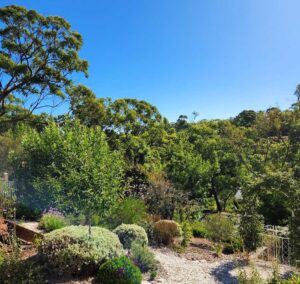
The true value of trees in our landscape
By Dan Austin
There is nothing so lonesome, morbid or drear, than to stand with a view of a landscape with no trees. It doesn’t quite have the same ring to it as the Slim Dusty classic “Pub with no beer” but the sentiment is spot on. Trees in our cities are notoriously undervalued; too easily cut down to make way for subdivisions and new developments without replacement. It’s a scenario brought about by the complexity of the true value of trees in our landscapes. They don’t scream out with monetary value and instead stand understated and silent, with their myriad of benefits concealed.
While the value of any one tree is difficult to quantify, a quick trip between a leafy green suburb to one lacking in established trees provides a series of obvious contrasts. The sounds to be heard are different, with the calls of numerous bird species found in the leafy suburbs giving way to the hum of traffic, or silence, in treeless streets. Trees provide valuable habitats for all sorts of life and large established trees are of particular value, with nesting hollows often taking over one hundred years to form. In the peak of summer, the value of the cooling effect of trees becomes apparent between suburbs, as bitumen bakes in the absence of shade offered by trees, while in times of rain, the surface area provided by established tree canopies slows the passage of water to stormwater drains, reducing the risk of flooding.

House and land values are higher in areas rich in trees, and there are numerous studies that indicate a prevalence of green space that correlates with reduced crime rates, improved physical and mental health, and strengthened communities. Amongst other benefits, trees can sequester carbon, improve air quality, and remove contaminants from soil.
Realising these benefits, and more, it is encouraging to see many councils putting more emphasis on establishing new street tree plantings, and maintaining those already in existence with greater care. However, alongside this positive trend is another of subdivision of domestic properties and a reduction in the size of urban yards. Establishing trees in smaller spaces can be challenging, but it isn’t impossible. Thanks to a commendable nursery industry in Australia, there is a tree available for just about any situation.
So, what is on offer out there to suit those niche challenges posed by small spaces?
For height and quantity in a small footprint, columnar or fastigiate forms of tree species are the way to go, and breeders have been improving many of these for some time, so there are great options out there. Hardy deciduous species with a showy flower displays to consider include Prunus serrulata ‘Amanogowa’, Malus trilobata, Prunus cerasifera ‘Nigra fastigiata’, and the ever-popular Pyrus calleryana ‘Capital’. Upright evergreen species are also numerous and a few to consider include Banksia integrifolia ‘Sentinel’, Callistemon viminalis SlimTM, Elaeocarpus reticulatus ‘Dark Pink Elly’ and classic conifers such as Cupressus sempervirens ‘Stricta’ or Thuja occidentalis ‘Smaragd’.

If it is a small-space feature tree that is required, the options continue. Popular evergreen species include Magnolia cultivars such as ‘Little Gem’, ‘Kay Paris’ and ‘Teddy Bear’, although in cooler climates there are even more magnolias to investigate including Magnolia figo and Magnolia ‘Inspiration’. Dwarf Corymbia ficifolia cultivars are available in an increasing range of colours, or for a drought-tolerant hardy feature tree with a dense canopy, why not look at Geijera parviflora? Deciduous species suited to this scenario include the huge variety of Malus and Lagerstroemia indica cultivars available.
There are also many weeping feature trees suited to small spaces. Often, weeping trees have been achieved by grafting prostrate or cascading forms of plants onto established standard trunks. This means they don’t develop a great deal of height once grafted and can be maintained at a size relatively close to the size they are when purchased. Some stand-out weeping feature trees to consider include an incredible range of standard grevilleas and acacias, Prunus mume ‘Pendula’, Prunus persica ‘Crimson Cascade’, and Prunus yedoensis x subhirtella ‘Snofozam’.
Another group of trees perfectly suited to small spaces are fruit trees. Whether it is because of dwarfing rootstock or through pruning techniques such as espalier, fruit trees can be grown in the smallest of spaces and provide a productive crop, adding another layer to the value of trees. Many are also highly ornamental and produce spring flower displays that are hard to match.
Regardless of the tree chosen, with variety like this, there is an opportunity to add a tree to the suburban landscape in any situation and while small trees may not offer all the benefits of their larger cousins, any tree is better than no tree.
Once the choice is made regarding species, a decision needs to be made regarding what size to buy, and while the tree may need to fit in a small space, a final piece of advice is to always buy the largest specimen you can afford. What you are buying is time, and in the nursery industry it comes at a bargain price.
For more great information on the value of our trees visit the Treenet website https://treenet.org/
Dan Austin
IPPS Member, Author
Lecturer, TAFE South Australia
M: 049 122 8591
E: daniel.austin@outlook.com
FB: BeyondGreenAustralia
W: ipps.org
Main photo: A fallen branch wound is only one step in the creation of nesting hollows that may take over one hundred years to form
